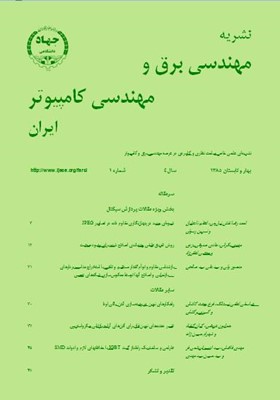روش تفريق طيفی چندباندی اصلاح شده برای بهبود صحبت
محورهای موضوعی : مهندسی برق و کامپیوترمهدی بکرانی 1 , هادی صدوقی یزدی 2
1 - دانشگاه تربیت مدرس
2 - دانشگاه تربیت معلم سبزوار
کلید واژه: تفريق طيفی چندبانديبهبود صحبتنويز غيرايستانفاکتور فوقتفريقنويز موزيکال,
چکیده مقاله :
در اين مقاله يک روش اصلاح شدة تفريق طيفی چندباندی برای حذف نويز از سيگنال صحبت ارائه شده است. در اين روش با تخمين آمارگان نويز غيرايستان، تخمينی از SNR برای سيگنال صحبت بدست ميآيد که در ميانگينگيری وفقی از قابهای سيگنال صحبت بکار گرفته ميشود. همچنين با استفاده از آن يک فاکتور فوقتفريق بدست ميآيد که سبب کاهش قابل توجه نويز موزيکال ميشود. تنظيم پارامترهای الگوريتم نهايی بر اساس SNR بدست آمده انجام ميشود؛ بطوريکه الگوريتم نهايی دارای حداقل نويز موزيكال و اعوجاج در سيگنال صحبت است. نتايج حاصل از معيارهای ايتاکورا-سايتو، SNR سراسری و SNR قطعهای نشان ميدهد که الگوريتم پيشنهادی دارای سيگنال خروجی با کيفيت بهتری نسبت به دو الگوريتم تفريق طيفی چندباندی و نوع بهبوديافته آن ميباشد.
In this paper, a modified multi band spectral subtraction is proposed for speech denoising. In this method by estimating the non-stationary noise statistics an estimate of the SNR for the speech signal is obtained which is used in the adaptive averaging of the speech signal frames. In addition, by employing such estimate an over-subtraction factor can be obtained which substantially reduces the musical noise. The adjustment of the final algorithm parameters is accomplished based on the obtained SNR, such that the final algorithm has a minimum musical noise and distortion in the speech signal. The obtained results from the Itakura-Saito, global SNR and segmental SNR show that the proposed algorithm has an output signal with a superior quality compared to the multi-band spectral subtraction algorithm and its modified version.
[1] S. V. Vaseghi, Advanced Digital Signal Processing and Noise Reduction, John Wiley& Sons, Ltd., 2000.
[2] H. Gustafsson, S. E. Nordholm, and I. Claesson, "Spectral subtraction using reduced delay convolution and adaptive averaging," IEEE Trans. on Speech and Audio Processing, vol. 9, no. 8, pp. 799-807, Nov. 2001.
[3] K. Yamashita, S. Ogata and T. Shimamura, "Spectral subtraction iterated with weighting factors," in Proc. IEEE Speech Coding Workshop, pp. 138-140, Oct. 2002.
[4] L. Lin, E. Ambikairajah, and H. Holmes, "Speech enhancement for nonstationary noise environment," in Proc. Asia-Pacific Conf. on Circuits and Systems, vol. 1, pp. 177-180, Oct. 2002.
[5] D. Almagor, Enhancement of Noisy Speech Signals by Low-Cost, Adaptive Methods, National Semiconductor Corporation, DSP Technology Group, pp. 25-28, 1986.
[6] B. L. Sim, Y. C. Tong, J. S. Chang, and C. T. Tan, "A parametric formulation of the generalized spectral subtraction method," IEEE Trans. on Speech and Audio Processing, vol. 6, no. 4, pp. 328-337, Jul. 1998.
[7] S. F. Boll, "Suppression of acoustic noise in speech using spectral subtraction," IEEE Trans. on Acoustica, Speech and Signal Processing, vol. 27, no. 2, pp. 113-120, Apr. 1979.
[8] J. Poruba, "Speech enhancement based on nonlinear spectral subtraction," in Proc, Fourth IEEE Int. Caracas Conf. on Devices, Circuits, and Systems, pp. T031-1-T031-4, 2002.
[9] S. F. Boll, "A spectral subtraction algorithm for suppression of acoustic noise in speech," in Proc. IEEE International Conference on Acoustics, Speech, and Signal Processing, pp. 200-203, Apr. 1979.
[10] A. Lagler, G. Gruhler, P. Sovka, V. Davidek, and & P. Pollak, Real-time Fixed-point DSP-implementation of Spectral Subtraction Algorithm for Speech Enhancement in Noisy Environment, Fachhochschule Heilbronn, University for Applied Sciences, D-74081 Heilbronn, Germany, Czech Technical University Prague, Fac. of Electrical Engineering, Dpt. Of Cicuit Theory Technicka2, 16627, Praha 6, Czech Republic, 1996.
[11] P. Lockwood and J. Boudy, "Experiments with a non-linear spectral subtractor (NSS), hidden Markov models and the projections, for robust recognition in cars," Speech Comm., vol. 11, no. 2-3, pp. 215-228, June 1992.
[12] C. He and G. Zweig, "Adaptive two-band spectral subtraction with multi-window spectral estimation," in Proc. IEEE Int. Conf. on Acoustics, Speech, and Signal Processing, vol. 2, pp. 793-796, Mar. 1999.
[13] Md. Kamrul Hasan, S. Salahuddin, and M. Rezwan Khan, "A modified a priori SNR for speech enhancement using spectral subtraction rules", IEEE Signal Processing Letters, vol. 11, no. 4, pp. 450-453, Apr. 2004.
[14] K. Wu and P. Chen, "Efficient speech enhancement using spectral subtraction for car hands-free application," in Proc. Int. Conf. on Consumer Electronics, vol. 2, pp. 220-221, 2001.
[15] S. D. Kamath, A Multi-Band Spectral Subtraction Method for Speech Enhancement, M.Sc Thesis in Electrical Eng., University of Texas at Dallas, Dec. 2001.
[16] S. Kamath, and P. Loizou, "A multi-band spectral subtraction method for enhancing speech corrupted by colored noise," in Proc. IEEE Int. Conf. on Acoustics, Speech, and Signal Processing, vol. 4, p. 4164, Orlando, US, May 2002.
[17] Y. Ghanbari, M. R. Karami-Mollaei, and B. Amelifard, "Improved multi-band spectral subtraction method for speech enhancement," in Proc. The Sixth IASTED Int. Conf. on Signal and Image Processing, pp. 225-250, Honolulu, US, Aug. 2004.
[18] http://www.speech.cs.cmu.edu/comp.speech/section1/data/noisex.html
[19] J. R. Deller, Jr., J. H. L. Hansen, and J. G. Proakis, Discrete-Time Processing of Speech Signals, IEEE Press, Piscataway, NJ, 2000.
[20] L. Lin, W. H. Holmes, and E. Ambikairajah, "Subband noise estimation for speech enhancement using a perceptual wiener filter," in Proc. IEEE Int. Conf. on Acoustics, Speech, and Signal Processing, vol. 1, pp. 80-83, Apr. 2003.
[21] R. Martin, "Noise power spectral density estimation based on optimal smoothing and minimum statistics," IEEE Trans. Speech and Audio Processing, vol. 9, no. 5, pp. 504-512, Jul. 2001.
[22] M. Berouti, R. Schwartz, and J. Makhoul, "Enhancement of speech corrupted by acoustic noise," in Proc. IEEE Int. Conf. on Acoustics, Speech, and Signal Processing, pp. 208-211, Apr. 1979.
[23] "IEEE recommended practice for speech quality measurement," IEEE Trans. on Audio and Electroacoustics, vol. 17, no. 3, pp. 227-246, Sept. 1969.


